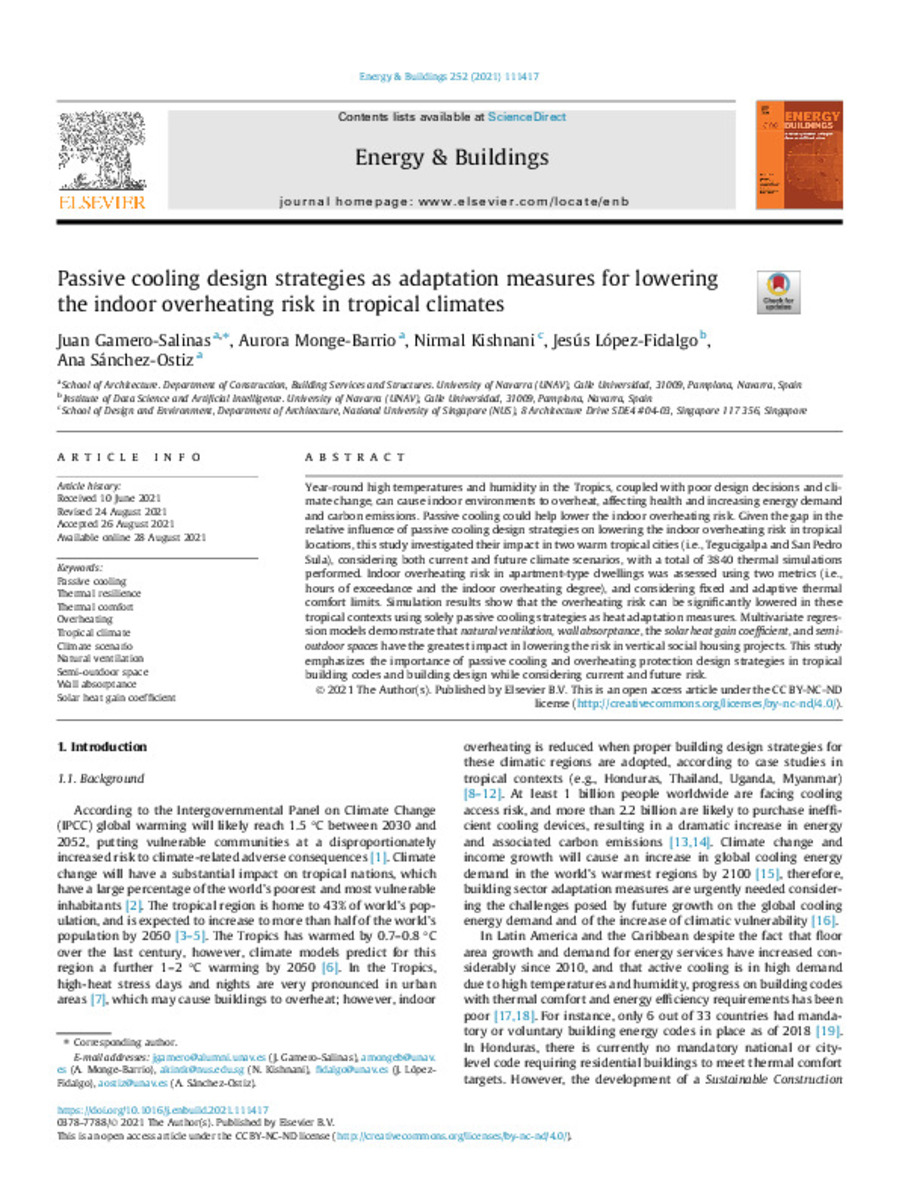Full metadata record
| DC Field | Value | Language |
|---|---|---|
| dc.creator | Gamero-Salinas, J. (Juan) | - |
| dc.creator | Monge-Barrio, A. (Aurora) | - |
| dc.creator | Kishnani, N. (Nirmal) | - |
| dc.creator | López-Fidalgo, J. (Jesús) | - |
| dc.creator | Sánchez-Ostiz, A. (Ana) | - |
| dc.date.accessioned | 2022-04-06T11:43:52Z | - |
| dc.date.available | 2022-04-06T11:43:52Z | - |
| dc.date.issued | 2021 | - |
| dc.identifier.citation | Gamero-Salinas, J. (Juan); Monge-Barrio, A. (Aurora); Kishnani, N. (Nirmal); et al. "Passive cooling design strategies as adaptation measures for lowering the indoor overheating risk in tropical climates". Energy and Buildings. 252 (111417), 2021, | es_ES |
| dc.identifier.issn | 0378-7788 | - |
| dc.identifier.uri | https://hdl.handle.net/10171/63363 | - |
| dc.description.abstract | Year-round high temperatures and humidity in the Tropics, coupled with poor design decisions and climate change, can cause indoor environments to overheat, affecting health and increasing energy demand and carbon emissions. Passive cooling could help lower the indoor overheating risk. Given the gap in the relative influence of passive cooling design strategies on lowering the indoor overheating risk in tropical locations, this study investigated their impact in two warm tropical cities (i.e., Tegucigalpa and San Pedro Sula), considering both current and future climate scenarios, with a total of 3840 thermal simulations performed. Indoor overheating risk in apartment-type dwellings was assessed using two metrics (i.e., hours of exceedance and the indoor overheating degree), and considering fixed and adaptive thermal comfort limits. Simulation results show that the overheating risk can be significantly lowered in these tropical contexts using solely passive cooling strategies as heat adaptation measures. Multivariate regression models demonstrate that natural ventilation, wall absorptance, the solar heat gain coefficient, and semi-outdoor spaces have the greatest impact in lowering the risk in vertical social housing projects. This study emphasizes the importance of passive cooling and overheating protection design strategies in tropical building codes and building design while considering current and future risk. | es_ES |
| dc.description.sponsorship | Friends of the University of Navarra (UNAV) for funding corresponding author’s PhD programme. | es_ES |
| dc.language.iso | eng | es_ES |
| dc.publisher | Elsevier | es_ES |
| dc.rights | info:eu-repo/semantics/openAccess | es_ES |
| dc.subject | Passive cooling | es_ES |
| dc.subject | Thermal resilience | es_ES |
| dc.subject | Thermal comfort | es_ES |
| dc.subject | Overheating | es_ES |
| dc.subject | Tropical climate | es_ES |
| dc.subject | Climate scenario | es_ES |
| dc.subject | Natural ventilation | es_ES |
| dc.subject | Semi-outdoor space | es_ES |
| dc.subject | Wall absorptance | es_ES |
| dc.subject | Solar heat gain coefficient | es_ES |
| dc.title | Passive cooling design strategies as adaptation measures for lowering the indoor overheating risk in tropical climates | es_ES |
| dc.type | info:eu-repo/semantics/article | es_ES |
| dc.description.note | This is an open access article under the CC BY-NC-ND license | es_ES |
| dc.identifier.doi | 10.1016/j.enbuild.2021.111417 | - |
| dadun.citation.number | 252 | es_ES |
| dadun.citation.publicationName | Energy and Buildings | es_ES |
| dadun.citation.startingPage | 111417 | es_ES |
Files in This Item:
Statistics and impact
Items in Dadun are protected by copyright, with all rights reserved, unless otherwise indicated.






